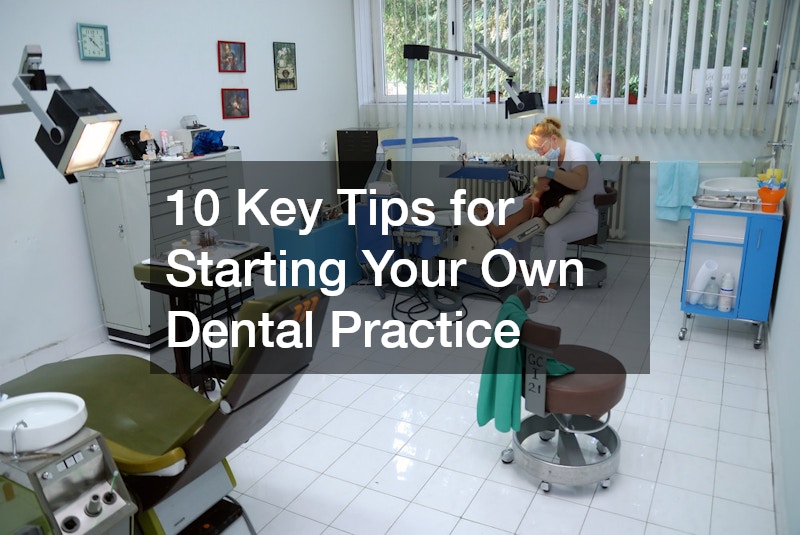Starting your own dental practice is both a major professional milestone and a complex business challenge. It’s more than just finding patients—it’s about creating a lasting, trusted dental office that reflects your vision, values, and dedication to care. From business planning and financing to branding and patient relationships, every decision influences your long-term success. With thoughtful preparation and a commitment to quality service, your new venture can thrive in a competitive healthcare environment.
A dental practice doesn’t just appear overnight; it’s built step by step through smart strategy and consistency. From securing capital and designing a welcoming space to hiring capable staff and establishing trust with patients, each stage carries equal importance. By focusing on long-term goals and creating systems that promote efficiency, your dental office can operate smoothly while providing excellent patient care. With these ten key tips, you’ll be equipped to turn your dream practice into a sustainable, respected local business.
1. Plan Your Vision

Every successful dental practice begins with a clear vision and purpose. Before anything else, decide what you want your dental office to represent in your community. Your vision should encompass not only the type of patients you want to serve but also the kind of experience you want to deliver. Whether you’re aiming to build a high-tech clinic or a cozy family-friendly space, understanding your core goals will help guide every business decision.
A clear mission statement and set of values can also steer your marketing, staff training, and patient care strategies. Consider what differentiates your practice from others in the area. Are you focusing on affordability, specialized treatments, or a relaxing environment for anxious patients? Outlining these details early on helps you stay consistent as your business grows.
Creating a comprehensive business plan ensures that your goals remain achievable. Include information on projected costs, expected growth, and milestones for expansion. Your plan will act as a roadmap not only for you but also for investors and lenders who need assurance that your dental office is built for long-term success. It’s this clarity of purpose that keeps your dental office focused and adaptable as patient needs and industry trends evolve.
2. Secure Financing
Opening a dental office requires a significant financial investment, from securing property to purchasing essential equipment. Many new owners underestimate the total startup costs, which can include everything from dental chairs and sterilization units to software systems and marketing materials. A dentist stepping into ownership should explore multiple financing options, such as bank loans, specialized dental lenders, or lines of credit tailored for medical professionals.
Once you have a realistic understanding of your financial needs, create a detailed budget that covers both startup and operational expenses. It’s crucial to plan for the first six to twelve months when profits might not yet offset costs. Account for rent, utilities, employee wages, and marketing efforts. This approach prevents financial strain and ensures that your dental office remains stable during its initial growth phase.
When working with financial advisors or lenders, maintain transparency about your goals and timelines. A solid business plan backed by realistic financial projections demonstrates responsibility and foresight. Proper financing isn’t just about getting your doors open—it’s about sustaining your practice until patient volume and revenue reach a steady rhythm. By maintaining financial discipline and tracking performance, you’ll ensure your dental office grows steadily without unnecessary debt.
3. Pick the Right Spot

Location can make or break a dental office. The area you choose should balance accessibility, visibility, and proximity to your target patient demographic. High-traffic neighborhoods near schools, shopping centers, or residential zones often provide steady patient flow and lots of visibility. However, affordability and competition levels should also factor into your final decision.
Before signing a lease, research local regulations, zoning requirements, and parking availability. Evaluate how easy it will be for patients to find and reach your location. Consider working with professionals who can handle tasks like the local office furniture install to ensure your space is functional and efficient. A thoughtful layout can improve patient experience and create a professional environment that builds confidence from the moment people walk in.
Think about future growth as well. Your chosen location should have room for expansion or additional operatories if needed. A good dental office location will allow you to grow naturally without forcing a move too soon—a costly and disruptive process. A well-chosen site not only attracts patients but also strengthens your dental office’s reputation as a convenient and dependable local provider.
4. Design the Space
Your practice’s physical design plays a major role in patient comfort and workflow efficiency. A well-designed dental office should feel welcoming, clean, and modern. The aesthetic should reflect professionalism while reducing anxiety, especially for patients who are nervous about visits. Thoughtful design choices can influence first impressions and even patient retention.
Functionality matters just as much as appearance. Ensure your layout supports smooth movement between treatment areas, waiting rooms, and administrative zones. Accessibility, privacy, and sanitation should all guide your planning. When choosing furniture and equipment, balance practicality with comfort so both staff and patients benefit from the space.
Working with an experienced designer familiar with medical or dental layouts can help you make the most of your space. Whether you’re fitting in dental bridges or advanced imaging systems, consider the long-term flow of traffic and future upgrades. A well-planned environment supports productivity and patient satisfaction alike. This attention to detail in design enhances workflow and creates a lasting impression that reflects the professionalism of your dental office.
5. Hire Your Team

No dental office thrives without a dedicated and qualified team. Hiring skilled staff—receptionists, hygienists, assistants, and administrative personnel—ensures smooth day-to-day operations. Every member should align with your vision and demonstrate professionalism, empathy, and strong communication skills. A cohesive team contributes significantly to a welcoming, efficient atmosphere.
When hiring, prioritize candidates who reflect your practice’s culture and patient philosophy. For example, family dentists often look for staff who excel at creating comfort for children and parents alike. Proper onboarding and training can further reinforce your office values and operational standards, setting the tone for long-term collaboration.
Beyond technical competence, invest in building trust and loyalty among your staff. Regular meetings, professional development, and clear communication channels create a workplace where employees feel valued. A positive environment enhances patient experiences and supports your dental office’s reputation. When your employees feel invested and supported, they become ambassadors for your dental office’s commitment to exceptional patient care.
6. Select Equipment
Choosing reliable equipment is one of the most critical investments you’ll make for your dental office. The right technology allows you to perform precise, efficient treatments while maintaining patient safety and comfort. From chairs and lights to sterilization systems, every piece of equipment should be chosen for durability and ease of use.
When expanding your range of services, consider future additions such as digital imaging, CAD/CAM systems, or dental implants. Advanced tools help you stay competitive and attract patients seeking specialized care. It’s essential to work with reputable suppliers who can provide installation, warranties, and ongoing support.
Proper maintenance and regular inspections ensure equipment longevity. Build relationships with vendors who can assist with timely repairs and software updates. A well-equipped dental office not only enhances clinical outcomes but also reinforces confidence among your patients and staff. Staying current with emerging technologies ensures your dental office continues offering advanced, efficient, and comfortable treatment options.
7. Set Legal Protections

Establishing proper legal safeguards is non-negotiable when opening a dental office. From business licensing to liability coverage, compliance protects you from costly disputes or penalties. Seek advice from a medical malpractice lawyer to ensure that your practice meets all legal standards and that your documentation is airtight.
Proper contracts, patient consent forms, and employment agreements protect everyone involved in your practice. These legal measures also clarify expectations and responsibilities. Staying compliant with HIPAA and OSHA standards is equally vital to protect patient data and maintain safe working conditions.
Taking the time to understand local, state, and federal regulations will help you avoid issues that could damage your reputation. Investing in legal counsel early saves time and stress later. A secure legal foundation allows your dental office to operate confidently and ethically. Protecting your business from legal risks allows you to concentrate on delivering excellent care and building patient trust within your dental office.
8. Build Client Trust
Trust is the cornerstone of every successful dental office. Patients are more likely to return and refer others when they feel genuinely cared for and respected. Delivering consistent, high-quality service and maintaining open communication are key factors in building that trust.
Offering preventive care such as teeth cleaning and patient education promotes long-term relationships. Explain treatment options clearly and answer questions thoroughly to foster transparency. When patients know you prioritize their comfort and health, they develop confidence in your expertise.
Small gestures—like remembering patient names or following up after appointments—can make a big difference. Building strong rapport turns first-time visitors into lifelong clients and strengthens your reputation within the community. Over time, these genuine connections transform your dental office into a reliable community resource people are proud to recommend.
9. Market Your Practice
Marketing plays a vital role in helping your dental office grow and reach the right audience. In a competitive industry, it’s not enough to rely on word of mouth alone. A strong digital presence, combined with community involvement, ensures steady patient acquisition.
Consider working with a professional service brand agency to craft your logo, website, and advertising campaigns. Consistent branding builds recognition and credibility. Leverage social media, online reviews, and local SEO to make your practice visible to nearby patients searching for quality care.
Track your marketing results to see which strategies deliver the best return on investment. Focusing on targeted outreach helps you spend smarter while growing your patient base steadily over time. A strong marketing foundation keeps your dental office relevant and thriving. With consistent messaging and authentic outreach, your dental office can establish a strong, recognizable brand that inspires confidence.
10. Grow with Feedback
Growth depends on your willingness to listen and adapt. Encourage feedback from both patients and staff to identify areas that need improvement. Constructive criticism can highlight opportunities to refine processes, update technology, or enhance patient experiences.
Cosmetic dentists often use feedback to refine aesthetic services and introduce new techniques based on patient demand. Regularly review satisfaction surveys, online comments, and internal suggestions to spot recurring themes. These insights can guide decisions on upgrades, service expansion, and staff training.
By embracing feedback, you create a culture of continuous improvement within your dental office. Patients appreciate knowing their opinions matter, while staff members feel empowered to contribute. This ongoing evolution is what transforms a good practice into a great one. This dedication to improvement ensures your dental office remains innovative, trusted, and ready to meet future challenges head-on.
A successful dental office is built on careful planning, smart financial management, and genuine dedication to patient care. From your initial vision to the final stages of growth, each decision plays a vital role in shaping the future of your business. Building strong systems, hiring the right team, and maintaining compliance lay a solid foundation that supports your goals. Over time, these investments yield trust, loyalty, and profitability.
As you move forward, remember that opening a dental practice isn’t a one-time event—it’s a continuous process of learning and adapting. Marketing, branding, and feedback collection all ensure that your services remain relevant in an ever-evolving field. By combining clinical excellence with strong leadership, you can create a dental office that stands out in your community for quality and care.
Launching your own dental practice may seem overwhelming, but with dedication, foresight, and the right support network, success is within reach. Following these ten key tips for starting your own dental practice provides a roadmap for stability, growth, and satisfaction. When you focus on building relationships, maintaining integrity, and providing exceptional care, your dental office will not only thrive—it will become a cornerstone of your community for years to come.

